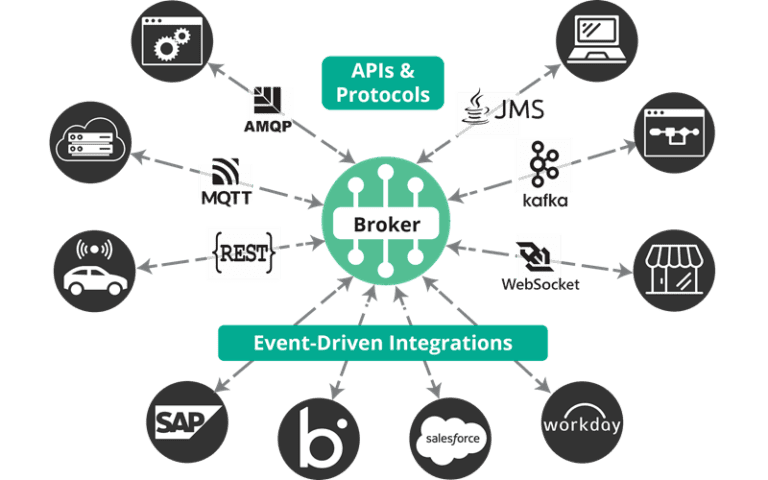As technology compartmentalises, we still need to coalesce, corral and conjoin components. Real-time event-driven integration and streaming platform company Solace is aiming to weave together even the tiniest elements of the distributed and componentised IT stack with new micro-integrations in its Solace PubSub+ Platform. The company’s micro-integrations are lightweight event-driven integration “modules” that connect enterprise technologies (including legacy applications) such as cloud services, messaging services, databases, files, AI agents and so on to an event-driven distribution layer, called an event mesh, enabling information exchange in real-time.
What is an event mesh?
An event mesh is a software architecture layer designed to connect “events” (in the form of any computing execution that might involve a read or write operation, an analysis function, a storage action or some other call to a library or elsewhere) from one application to be dynamically routed and received by any other application in any location across any cloud entity. It is built by constructing a network of event brokers, technologies which are a modern form of messaging middleware that are designed to move events across the distributed enterprise.
Specifically, PubSub+ Micro-Integrations have been engineered to “liberate events data from source systems” so it can be streamed over an event mesh. This means the data can then be more easily integrated into target systems i.e. the ones where it will be its next job.
“Over the years many things have changed, but the always-driving business need to do more workloads in real-time has not. As we move forward, there will always be more demand for real-time data and not less. Nobody wants to go backwards to the old days when everything was batch processing,” said Jeff Pollock, VP of products and cloud services for data replication, streaming data and database migrations at Oracle in a recent blog.
Consisting of a connector to get events on and off the event mesh, as well as one or more processors that transform event data for easy re-use by other micro-integrations, Solace PubSub+ Micro-Integrations are designed to help enterprises gain more value from their existing iPaaS and API management platforms.
What’s wrong with integration?
The company says that “traditional integration solutions” often suffer from latency, complexity and performance bottlenecks due to centralised data processing and intricate network configurations. Solace PubSub+ Micro-Integrations are positioned as an improved way to handle connectivity and transformations near the systems to which they link in the event mesh. The firm also calls out the fact that many integration solutions also rely on tightly coupled integrations that make systems difficult and risky to change. In response then, the modular and decoupled nature of Solace PubSub+ Micro-Integrations is said to make it easier to integrate new applications and technologies like the AI agents, vector databases and large language models.
“Enterprises have been accelerating their investments in application modernisation to realise the benefits of cloud-native technologies. They are also aiming to enhance the execution of their digital business operations through continuous analysis of real-time data generated from IT and business events. They are seeking to become event-driven enterprises that maintain a constant state of awareness and are highly responsive to change, risk and opportunity,” wrote Carl Lehmann, senior research analyst for applied infrastructure & DevOps, S&P Global Market Intelligence.
Lehmann suggests that an event-driven enterprise can quickly sense and respond – reactively, predictively and even autonomously – to any changes in execution, performance, risks and opportunities.
Point-to-point integration
As more endpoints get linked by traditional integration solutions, point-to-point integration gets exponentially more complex, especially when information needs to be sent to multiple downstream systems. Solace yet again says it has an answer to this predicament because PubSub+ Micro-Integrations let systems scale by deploying additional instances at the source or target end of the equation, supporting increased traffic and distribution across multiple systems
“Point-to-point integrations present visibility and maintenance challenges due to their complex spaghetti architecture, making it difficult to identify and fix problems and frequently causing cascading failures due to tight coupling. Solace PubSub+ Micro-Integrations replace the chaos of point-to-point integrations with publish/subscribe distribution that offers superior transparency, traceability and troubleshooting,” said Shawn McAllister, CPO and CTO at Solace. “Solace micro-integrations will enable the event-driven integration it will take to meet the performance, reliability, agility and scalability needs of increasingly connected, real-time and intelligent enterprises.”
What is event-driven integration?
Event-driven integration is the application of event-driven architecture to integration, whereby integration functions such as connectivity, transformation and mapping are broken into smaller components and loosely coupled via the publish/subscribe exchange pattern – a lot like event-driven microservices. Event-driven integration complements API-led integration, meeting integration needs not well suited to synchronous or point-to-point integrations.
McAllister thinks that an event-driven integration approach moves integrations to the edge, with decentralised and real-time data flows and events in the middle, underpinned by an event mesh’s on-demand, “data as a service” network of event brokers, receiving messages in real-time and reacting accordingly. This is further complemented by an event portal, for the design and management of event streams and micro-integrations to facilitate connectivity of publishers and subscribers.
PubSub+ Micro-Integrations are now fully integrated into the Solace cloud platform. The promotional t-shirt (if there were one) here would state that the company is offering: “a single window” to view and track all integrations and events. In a fragmented world of distributed computing architectures with edge getting smarter and batch processing quietly (although perhaps quite gracefully) falling into obsolescence with technologies like Apache Kafka coming to the fore, real-time (in this case precision-engineered) integration and micro-integration may define the new topography of networked computing for us all.
